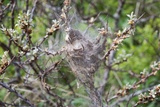Euproctis chrysorrhoea (Linnaeus, 1758) Species
Last modified: Nov. 10, 2025, 7:57 p.m.
A fairly common species throughout Belgium, sometimes a pest in parks and gardens.
This species is considered Least Concern according to the IUCN Red List category for Flanders 2023.
Details
- Classification
- Family: Erebidae > Subfamily: Lymantriinae > Tribus: Orgyiini > Genus: Euproctis > Species: Euproctis chrysorrhoea
- Vernacular names
- Bastaardsatijnvlinder (NL), Brown-tail (EN), Le Cul-brun (FR), Goldafter (DE)
- Synonyms
- Euproctis phaeorrhoea (Haworth, 1803)
- First mention in Belgium
- De Sélys-Longchamps E. 1837. Catalogue des Lépidoptères ou Papillons de la Belgique, précédé du tableau des Libellulines de ce pays. — — : 1–29. On page 27 (as Liparis Chrysorrhaea [sic]). view page
- Status
-
Native
Distribution
Bionomics
In autumn, the small caterpillars form colonies of larvae in trees and bushes constructed from a single leaf wrapped tightly with large amounts of white silk, which make a tough communal web. In spring, they emerge from the cocoon and grow into large caterpillars. By the end of June, the full-grown larvae start to pupate and the imago emerges towards the end of July. The adults come to light.
Flight periods
The adults fly in one generation a year from late May to late August.
Observed on
- Host plant (species):
- Hippophae rhamnoides and Prunus spinosa
- Host plant (genera):
- Crataegus
- Substrates:
- Deciduous trees and Shrubs
The larvae live gregariously in webs spun in bushes of Crataegus or Prunus spinosa, at the coast mainly on Hippophae rhamnoides.










